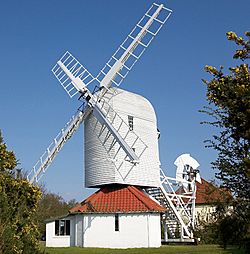Thorpeness Windmill facts for kids
Quick facts for kids Thorpeness Mill |
|
|---|---|

Thorpeness Mill
|
|
| Origin | |
| Mill name | Thorpeness Mill |
| Mill location | TM 468 598 |
| Coordinates | 52°10′53″N 1°36′32″E / 52.1815°N 1.6089°E |
| Operator(s) | Private |
| Year built | 1923 |
| Information | |
| Purpose | Pumping water |
| Type | Hollow Post mill |
| Roundhouse storeys | One storey |
| No. of sails | Four Sails |
| Type of sails | Patent sails |
| Windshaft | Cast iron |
| Winding | Fantail |
| Fantail blades | Six blades |
| Type of pump | Three throw pump |
The Thorpeness Windmill is a special old windmill located in Thorpeness, Suffolk, England. It's so important that it's a Grade II listed building, meaning it's protected because of its history. This windmill was first built way back in 1803 in a place called Aldringham.
Later, in 1923, it was carefully moved to Thorpeness. When it was first built, it was a corn mill, which means it ground grain into flour. But after it moved, it became a water pumping mill. Its new job was to pump water to a very unique building nearby called the House in the Clouds.
Contents
The Windmill's Journey and Purpose
From Grinding Corn to Pumping Water
The Thorpeness Mill began its life in 1803 as a corn mill in Aldringham. For many years, it helped local farmers by grinding their grain. In the 1890s, the Ogilvy family were the millers, working hard to keep the mill running.
Moving the Mill to Thorpeness
In the winter of 1922, something big happened. The mill was taken apart piece by piece by a company called Messrs Whitmore's, who were expert millwrights. A millwright is someone who builds and repairs mills. Amos Clarke was the person in charge of this huge task.
The mill was then rebuilt in Thorpeness. Its new purpose was to supply water to the House in the Clouds. This "house" is actually a water tower that was cleverly designed to look like a house.
Life at Thorpeness and Challenges
The windmill pumped water for the House in the Clouds until 1940. After that, an engine was installed to do the pumping instead.
During World War II, some children accidentally caused a problem. They blocked the tramway where the mill's winding wheels moved. This made the mill tilt forward, lifting its steps into the air! Even with many men trying to push it back, it wouldn't move. A millwright named Ted Friend from Whitmore's came and quickly fixed it with a sledgehammer.
In 1972, a big storm blew off the mill's fantail, which helps it turn into the wind. Then, in September 1973, a fire on the heath nearby damaged the mill. One of its sails and the main beam holding it were destroyed.
Restoration and New Ownership
Luckily, in 1975, several groups helped out. The Suffolk Coastal District Council, the Thorpeness Estate, and the Countryside Commission gave money to fix the mill. It was restored in 1977.
Later, Suffolk County Council bought the windmill from the Thorpeness Estate. In 2010, the Council decided to sell the windmill. They accepted an offer of £72,100 in November 2010.
How Thorpeness Mill Works
Understanding the Mill's Parts
The Thorpeness Mill is a type of windmill called a post mill. This means the main body of the mill, which holds all the machinery, can turn on a large central post. It sits on a single-storey roundhouse.
The mill turns itself into the wind using a fantail. This fantail has six blades and is arranged in a special way called the Suffolk style. The mill has four large sails, which are called Patent sails. These sails are attached to a strong cast-iron windshaft.
Pumping Water with Wind Power
Inside the mill, the brake wheel is connected to a special pump. This pump is called a three-throw pump. It was designed to pump water from a well that was about 28 feet (8.5 meters) deep. The water was then sent up to the tanks inside the House in the Clouds. The mill was powerful enough to pump about 1,800 imperial gallons (8,183 liters) of water every hour!
Millers of Thorpeness Mill
- Ogilvy (from the 1890s until 1922)
Visiting Thorpeness Windmill
Today, the Thorpeness Windmill is owned by a private individual. This means it's not usually open to the public all the time. However, the owner sometimes opens it for special visits. If you want to know more, you can look for "Friends of Thorpeness Windmill" on Facebook.

